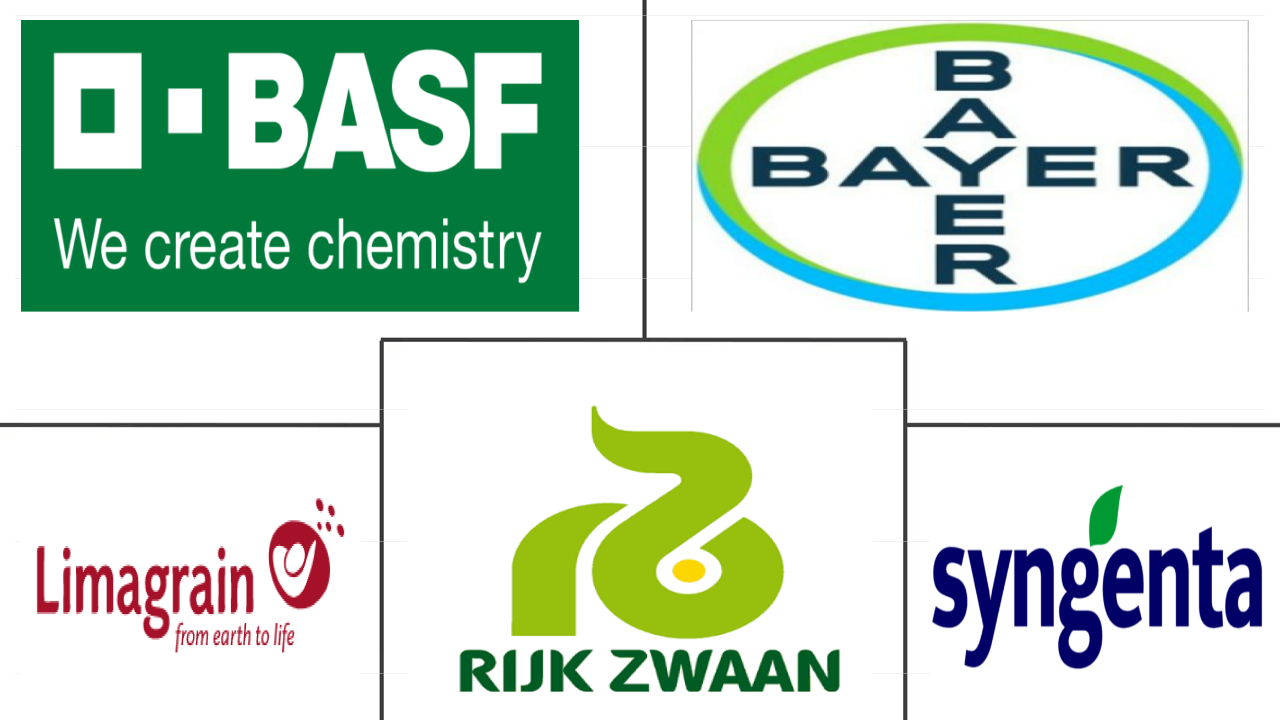Market Size of asia-pacific vegetable seed Industry
|
|
Study Period | 2017 - 2030 |
|
|
Market Size (2024) | USD 2.75 Billion |
|
|
Market Size (2030) | USD 3.67 Billion |
|
|
Largest Share by Breeding Technology | Hybrids |
|
|
CAGR (2024 - 2030) | 4.94 % |
|
|
Largest Share by Country | China |
Major Players |
||

|
||
|
*Disclaimer: Major Players sorted in no particular order |
Asia-Pacific Vegetable Seed Market Analysis
The Asia-Pacific Vegetable Seed Market size is estimated at 2.75 billion USD in 2024, and is expected to reach 3.67 billion USD by 2030, growing at a CAGR of 4.94% during the forecast period (2024-2030).
2.75 Billion
Market Size in 2024 (USD)
3.67 Billion
Market Size in 2030 (USD)
5.67 %
CAGR (2017-2023)
4.94 %
CAGR (2024-2030)
Largest Market by Crop Family
26.36 %
value share, Solanaceae, 2023
It is the largest segment due to the region's higher area under cultivation of tomatoes and chilies. China is the major producer of tomatoes across the world.
Largest Market by Country
36.53 %
value share, China, 2023
It is the largest producer of vegetables, such as tomato, onion, cabbage, and chili, in the region, accounting for around 30% of the global area under chili cultivation.
Fastest-growing Market by Crop Family
5.04 %
Projected CAGR, Brassicas, 2024-2030
It is the fastest-growing segment due to the growing demand for carrots, cabbages, and broccoli from consumers and the processing industry, along with its adaptability to different environments.
Fastest-growing Market by Country
6.91 %
Projected CAGR, Vietnam, 2024-2030
It is the fastest-growing segment due to an increase in the area under cultivation, which is associated with the surge in vegetable demand and higher adoption of hybrids.
Leading Market Player
8.69 %
market share, Groupe Limagrain, 2022

It is primarily focused on product innovations and partnerships. It has a partnership with Alteia to implement digital phenotyping plant breeding to develop improved varieties.
The increasing adoption of hybrid vegetable seeds and their benefits, such as higher yield, are anticipated to drive the hybrid seed market
- In Asia-Pacific, the hybrid seed segment dominated the market in terms of volume and value, which held 75.4% of the vegetable seed market value in 2022. The hybrid vegetable seed market grew by 32.4% between 2017 and 2022. This was mainly due to the high adoption of hybrid seed varieties in large countries such as China, India, and Bangladesh.
- Solanaceae and cucurbits dominated the Asia-Pacific hybrid vegetable seed market, collectively accounting for about 45.2% in 2022. This large market share of solanaceous and cucurbits seeds is mainly attributed to their significant demand in the region. Moreover, there has been an increase in seed replacement rate and rising awareness about the high-yielding varieties in the region.
- China and India were the region's major countries, collectively accounting for 61.3% of the hybrid vegetable market in 2022. This was mainly due to the presence of highly cultivatable areas, high consumer demand, and high usage of commercial hybrids.
- The open-pollinated varieties and hybrid derivatives held a market share of 24.6% in 2022. The low share was mainly due to an increased preference for high-yielding and disease-resistant hybrids.
- Among Asia-Pacific countries, China and India accounted for 63.2% of the open-pollinated variety market in 2022. Open-pollinated varieties require fewer inputs, such as fertilizers and pesticides, and are less expensive for low-income farmers. They also reduce the reliance on hybrid seed imports, thus boosting the market in the region.
- Therefore, with increasing food demand and the implementation of commercial hybrid varieties, hybrid breeding technology is likely to dominate the market during the forecast period.
An increase in the cultivation area, new technological advancements, and high global demand for vegetables are driving vegetable seed sales in the region
- The Asia-Pacific region is one of the largest producers and consumers of vegetables in the global market. In 2022, Asia-Pacific’s market share was 32.4% in 2022. China is a leading vegetable producer globally due to the presence of favorable weather conditions and high demand for vegetables globally and in the country.
- In Asia-Pacific, China dominated the vegetable seed market, accounting for 32.3% in 2022, followed by India with 23.5%, Japan with 8.5%, and Indonesia with 7.4%. Furthermore, China had the highest vegetable production, amounting to 596.0 million metric ton in 2021 and accounting for 51.9% of the global output.
- In India, the share of vegetable seeds is expected to increase during the forecast period due to the increasing demand for vegetables and growing awareness about their health benefit.
- Australia has a diverse agricultural sector, where vegetable farming is an important food source of income. It accounted for 4.6% of the Asia-Pacific vegetable seed market in 2022. The major vegetable crops grown in the country are onion, peas, pumpkin, squash, and tomato.
- In Japan, urban agriculture is developing as a new trend in agriculture. As agricultural land faces constraints, urban agriculture, such as greenhouse, has been expanding in the country. For instance, about 74% of tomatoes and 61% of cucumbers and gherkins in 2022 were cultivated under protected cultivation.
- Factors such as an increase in the cultivation area, new technological advancements, and high global demand are expected to fuel the growth of the vegetable seed market in the region during the forecast period.
Asia-Pacific Vegetable Seed Industry Segmentation
Hybrids, Open Pollinated Varieties & Hybrid Derivatives are covered as segments by Breeding Technology. Open Field, Protected Cultivation are covered as segments by Cultivation Mechanism. Brassicas, Cucurbits, Roots & Bulbs, Solanaceae, Unclassified Vegetables are covered as segments by Crop Family. Australia, Bangladesh, China, India, Indonesia, Japan, Myanmar, Pakistan, Philippines, Thailand, Vietnam are covered as segments by Country.
- In Asia-Pacific, the hybrid seed segment dominated the market in terms of volume and value, which held 75.4% of the vegetable seed market value in 2022. The hybrid vegetable seed market grew by 32.4% between 2017 and 2022. This was mainly due to the high adoption of hybrid seed varieties in large countries such as China, India, and Bangladesh.
- Solanaceae and cucurbits dominated the Asia-Pacific hybrid vegetable seed market, collectively accounting for about 45.2% in 2022. This large market share of solanaceous and cucurbits seeds is mainly attributed to their significant demand in the region. Moreover, there has been an increase in seed replacement rate and rising awareness about the high-yielding varieties in the region.
- China and India were the region's major countries, collectively accounting for 61.3% of the hybrid vegetable market in 2022. This was mainly due to the presence of highly cultivatable areas, high consumer demand, and high usage of commercial hybrids.
- The open-pollinated varieties and hybrid derivatives held a market share of 24.6% in 2022. The low share was mainly due to an increased preference for high-yielding and disease-resistant hybrids.
- Among Asia-Pacific countries, China and India accounted for 63.2% of the open-pollinated variety market in 2022. Open-pollinated varieties require fewer inputs, such as fertilizers and pesticides, and are less expensive for low-income farmers. They also reduce the reliance on hybrid seed imports, thus boosting the market in the region.
- Therefore, with increasing food demand and the implementation of commercial hybrid varieties, hybrid breeding technology is likely to dominate the market during the forecast period.
| Breeding Technology | |
| Hybrids | |
| Open Pollinated Varieties & Hybrid Derivatives |
| Cultivation Mechanism | |
| Open Field | |
| Protected Cultivation |
| Crop Family | ||||||||
| ||||||||
| ||||||||
| ||||||||
| ||||||||
|
| Country | |
| Australia | |
| Bangladesh | |
| China | |
| India | |
| Indonesia | |
| Japan | |
| Myanmar | |
| Pakistan | |
| Philippines | |
| Thailand | |
| Vietnam | |
| Rest of Asia-Pacific |
Asia-Pacific Vegetable Seed Market Size Summary
The Asia-Pacific vegetable seed market is experiencing significant growth, driven by the increasing adoption of hybrid seed varieties, particularly in large countries like China, India, and Bangladesh. The hybrid seed segment dominates both in volume and value, with solanaceae and cucurbits being the most prominent categories due to their high demand. The region's market is bolstered by the presence of highly cultivatable areas, substantial consumer demand, and the widespread use of commercial hybrids. While open-pollinated varieties hold a smaller market share, they remain important for low-income farmers due to their lower input requirements and cost-effectiveness. The region's vegetable seed market is further supported by technological advancements, expanding cultivation areas, and the growing global demand for vegetables.
China and India are key players in the Asia-Pacific vegetable seed market, with China leading in vegetable production and market share. The region's market is characterized by a diverse range of vegetable crops, with roots and bulbs like onions and potatoes occupying a significant portion of the cultivated area. The demand for seeds with traits such as disease resistance and adaptability to changing weather conditions is on the rise, driven by the need to enhance crop productivity and quality. Major companies like BASF SE, Bayer AG, and Syngenta are actively providing seed varieties with these desirable traits. The market is fragmented, with these companies holding a significant share, and recent collaborations and acquisitions are expected to further strengthen their positions and expand their product offerings.
Asia-Pacific Vegetable Seed Market Size - Table of Contents
-
1. MARKET SEGMENTATION (includes market size in Value in USD, Forecasts up to 2030 and analysis of growth prospects)
-
1.1 Breeding Technology
-
1.1.1 Hybrids
-
1.1.2 Open Pollinated Varieties & Hybrid Derivatives
-
-
1.2 Cultivation Mechanism
-
1.2.1 Open Field
-
1.2.2 Protected Cultivation
-
-
1.3 Crop Family
-
1.3.1 Brassicas
-
1.3.1.1 Cabbage
-
1.3.1.2 Carrot
-
1.3.1.3 Cauliflower & Broccoli
-
1.3.1.4 Other Brassicas
-
-
1.3.2 Cucurbits
-
1.3.2.1 Cucumber & Gherkin
-
1.3.2.2 Pumpkin & Squash
-
1.3.2.3 Other Cucurbits
-
-
1.3.3 Roots & Bulbs
-
1.3.3.1 Garlic
-
1.3.3.2 Onion
-
1.3.3.3 Potato
-
1.3.3.4 Other Roots & Bulbs
-
-
1.3.4 Solanaceae
-
1.3.4.1 Chilli
-
1.3.4.2 Eggplant
-
1.3.4.3 Tomato
-
1.3.4.4 Other Solanaceae
-
-
1.3.5 Unclassified Vegetables
-
1.3.5.1 Asparagus
-
1.3.5.2 Lettuce
-
1.3.5.3 Okra
-
1.3.5.4 Peas
-
1.3.5.5 Spinach
-
1.3.5.6 Other Unclassified Vegetables
-
-
-
1.4 Country
-
1.4.1 Australia
-
1.4.2 Bangladesh
-
1.4.3 China
-
1.4.4 India
-
1.4.5 Indonesia
-
1.4.6 Japan
-
1.4.7 Myanmar
-
1.4.8 Pakistan
-
1.4.9 Philippines
-
1.4.10 Thailand
-
1.4.11 Vietnam
-
1.4.12 Rest of Asia-Pacific
-
-
Asia-Pacific Vegetable Seed Market Size FAQs
How big is the Asia-Pacific Vegetable Seed Market?
The Asia-Pacific Vegetable Seed Market size is expected to reach USD 2.75 billion in 2024 and grow at a CAGR of 4.94% to reach USD 3.67 billion by 2030.
What is the current Asia-Pacific Vegetable Seed Market size?
In 2024, the Asia-Pacific Vegetable Seed Market size is expected to reach USD 2.75 billion.

